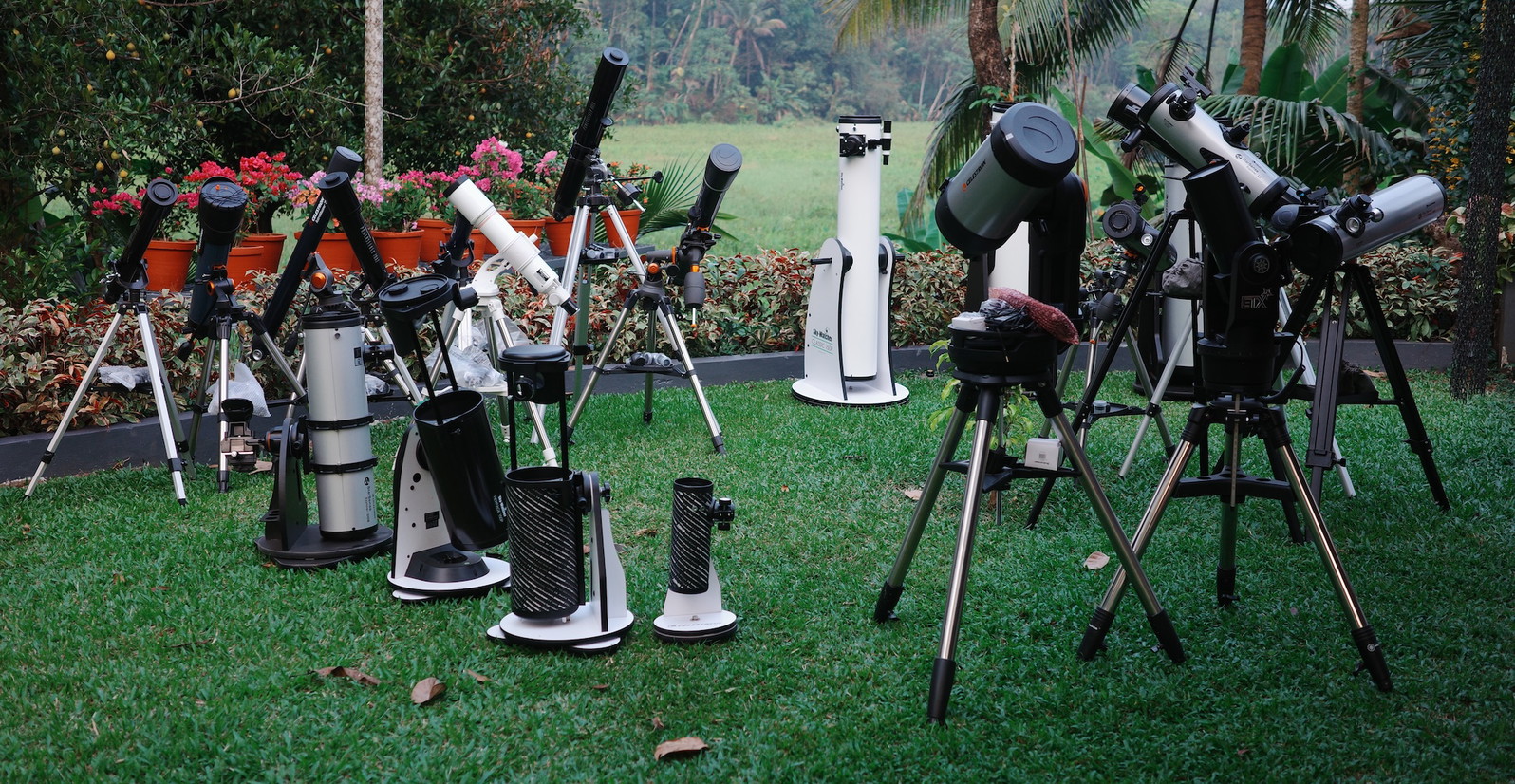
If you look at the list of best-selling telescopes on Amazon, you’ll see low-grade telescopes mostly reviewed by enthusiastic newbies who were excited to explore the night sky for the first time in their lives. Most of these beginners are content with seeing a few craters on the moon and spotting the four moons of Jupiter. Yet, unfortunately, they probably don’t know that any decent pair of astronomy binoculars that cost under $100 can show similar views.
Around 70% of knowledgeable telescope buyers spend between $200 and $800 on their first instrument. If you’re looking for a decent experience as a beginner, settle for something between $250 and $400. If you want to have a serious instrument that will last a lifetime with no corners cut, plan on spending $400-$1000 or more.
Do’s for Buying:
Consider a tabletop (5-6”) Dobsonian or a larger 8-12” Dobsonian as your first telescope choice.
If you want an especially portable telescope for close-up views of brighter targets and perhaps some day use, consider a 3-6” Maksutov-Cassegrain or Schmidt-Cassegrain telescope.
Our rankings detail plenty of price-sorted options beyond the popular choices.
Very high magnifications and the ability to see vivid color views of galaxies and nebulae are the most common of these claims in manufacturer advertising or product pages.
However, so too are the ability to do “astrophotography” with telescopes that can barely be kept aimed at an object for any length of time, “enhanced vision” or “AI” and other such buzzwords in telescopes with built-in electronics.
And there is the age-old brag of how many objects are in a computerized telescope’s database (here’s a hint: Most of those 40,000-odd catalog objects aren’t interesting, you can add more, or you can just connect a PC or smart device to the mount and control it with a third-party app like SkySafari).
Most filters, kits, and such marketed to beginners or included with telescopes are just tinted pieces of optically not-great glass that blur the image.
Color filters are really only used by the most demanding of planetary observers for special purposes; most light pollution filters are either only meant for astrophotography or simply do not do what is promised.
You don’t need a “moon filter” – moonlight won’t hurt your eyes, and a cheap one just smudges the view anyway.
For larger telescopes, I would recommend you consider a good UHC and/or oxygen-III nebula filter and not worry about anything else for a long time.
Many beginner scopes have one of these finders as a standard, but many telescopes come with finder scopes – essentially a mini telescope with crosshairs – packaged.
These finder scopes can often be decent enough, but with even an optically decent finder scope, you will often be dealing with an uncomfortable position to look through it, be unable to see the crosshairs, or you might have a finder that has a right-angled eyepiece configuration – which are great, but extremely hard to use on their own to aim most instruments.
A simple red dot sight works just fine on 6” and smaller telescopes; for larger ones, we recommend the Telrad or another reflex sight with a reticle.
Don’ts for Buying:
There are some educational/toy options that are okay, but if your goal is to actually view the night sky, a pair of 7×50 or 10×50 binoculars will get you a lot further for a lot less money.
If you are eyeing a $2500 8” Schmidt-Cassegrain that does it all because you haven’t decided whether your interests lie more in viewing or astrophotography, then perhaps consider starting with a smaller and cheaper telescope like a 6” or 8” Dobsonian.
If you are leaning towards viewing and a compact, easy-to-use astrophotography setup like the ZWO SeeStar or a star tracker for your DSLR, you are considering dipping your toes into astrophotography.
Telescopes are like tools. Surely you own more than one screwdriver.
If you have a big 10” or 12” Dobsonian, a smaller 4-6” tabletop unit or a similarly compact catadioptric telescope of the same aperture can be a good complement to it. If you’re worried about the size or commitment of a bigger and bulkier telescope, consider starting out with a telescope that will provide a quicker and more convenient alternative setup even once you’ve purchased the big one.
Likewise, you might want one telescope for viewing and one for astrophotography, which is also ideal since you can then look directly through the eyepiece at the cosmos while your other telescope captures hours-long photographic exposures.
Many telescopes only come with one or two eyepieces to start with, and these may or may not be of good quality. You need not spend much money; a decent set of 1.25” eyepieces, even if you are starting off with nothing, can be had for less than $100 USD. For many telescopes, just upgrading or adding an eyepiece at the higher magnification end can be enough.
In most cases, we would recommend you purchase dedicated eyepieces for different magnifications, but a good-quality Barlow lens can be handy to have as well.
This is a standard sign of low-quality workmanship, and few decent 0.965” eyepieces are available aftermarket; even if the telescope itself is actually good, it can be a headache to find a way to use eyepieces that are up to par.
Why trust my recommendations?
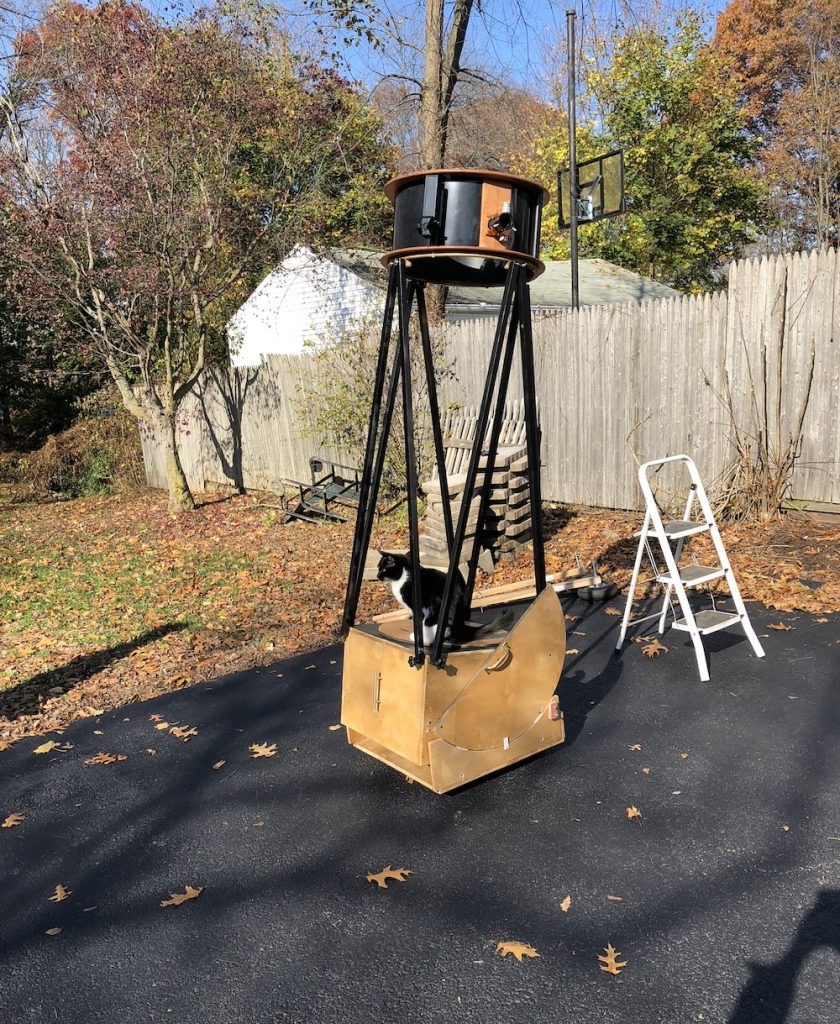
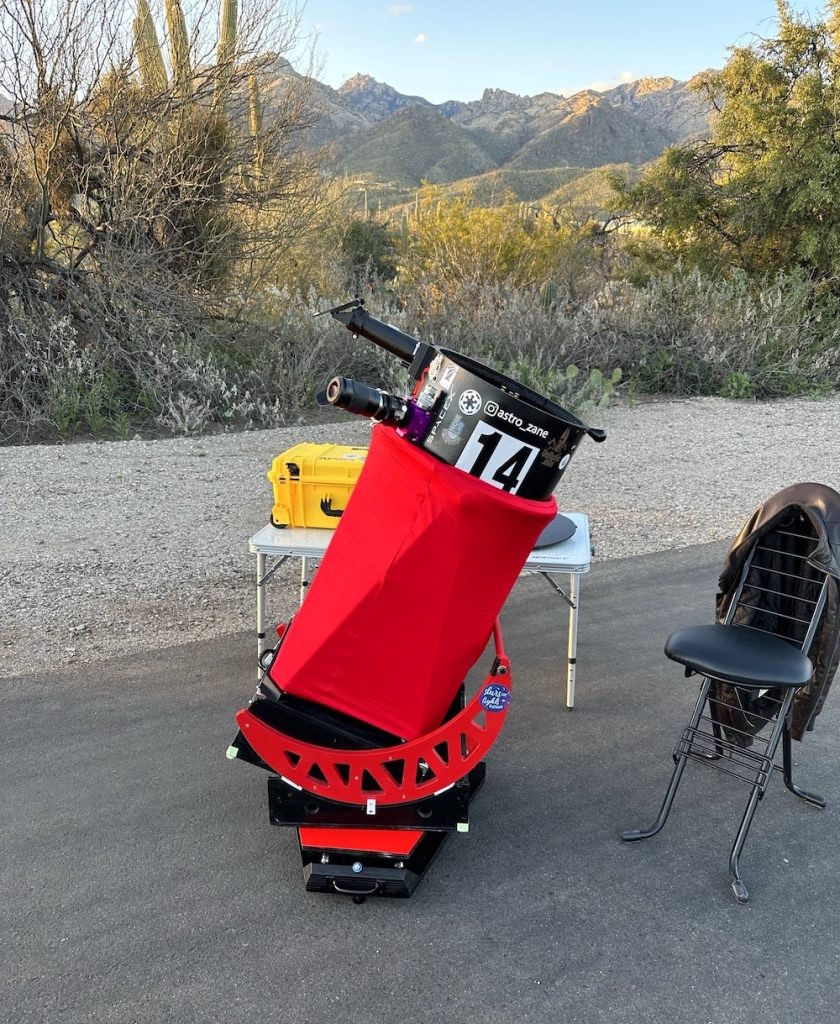
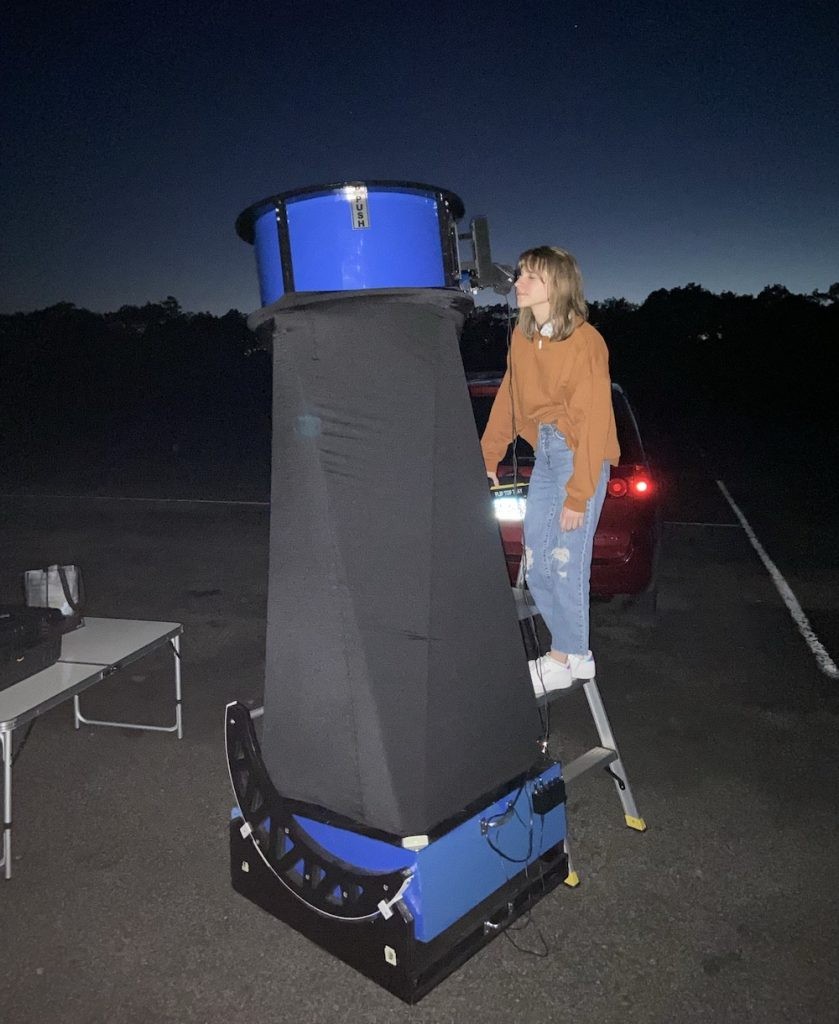
My first telescope was a Celestron NexStar 4SE, which I got for a Christmas. I had wanted a telescope since seeing the lunar eclipse in September of that year.
The 4SE immediately disappointed me when I learned that most deep-sky objects were little more than gray smudges, washed out from my light-polluted backyard, and hardly accommodated by this little Maksutov-Cassegrain’s small aperture and cramped field of view.
After a year of this, I upgraded to a 6” f/8 Newtonian and then to an old Meade 8” Schmidt-Cassegrain, which had some of the worst optics I have ever seen in a telescope.
Being a teenager and strapped for cash at the time, I ended up building my own telescopes of better quality, first a 6” f/4 and then a 16”, followed by a 20.5” and a 24”. After a while, I started buying, selling, fixing, and trading telescopes and building several more of them.
Today my largest telescope is a 14.7” f/2.9 Dobsonian, which I built and got a surprising amount of attention with 220K upvotes on r/space subReddit. Now, I am working on 18” and 30” telescopes.
Since getting my first telescope, as of the time of writing, I have owned over 430 telescopes, which includes most of the commercially available scopes in the US. Of these, I have actually used about 400 or so (a few dozen were never actually functional, e.g., the C5.5 film Schmidt camera). Of these, about 20 were built entirely by me, and I’ve restored dozens from parts piles back to working order.
I have ground mirrors up to 16” for my own telescopes, and I am now working on even larger homemade optics.
Any product I recommend at TelescopicWatch is going to do what it says and deliver on whatever our reviews promise—that’s it. No hyperbole, no exaggerated statements, no salesmanship. Just honest evaluations and reviews of quality telescopes.
Telescope Rules of Thumb:
- Dobsonian telescopes offer the biggest bang for your buck. If portability concerns you, tabletop Dobsonians and collapsible/truss tube Dobsonians can fit practically anywhere. PushTo Dobsonians offer computer assistance to find your target, while the more pricey GoTo Dobsonians automatically point at and track targets after a simple alignment procedure.
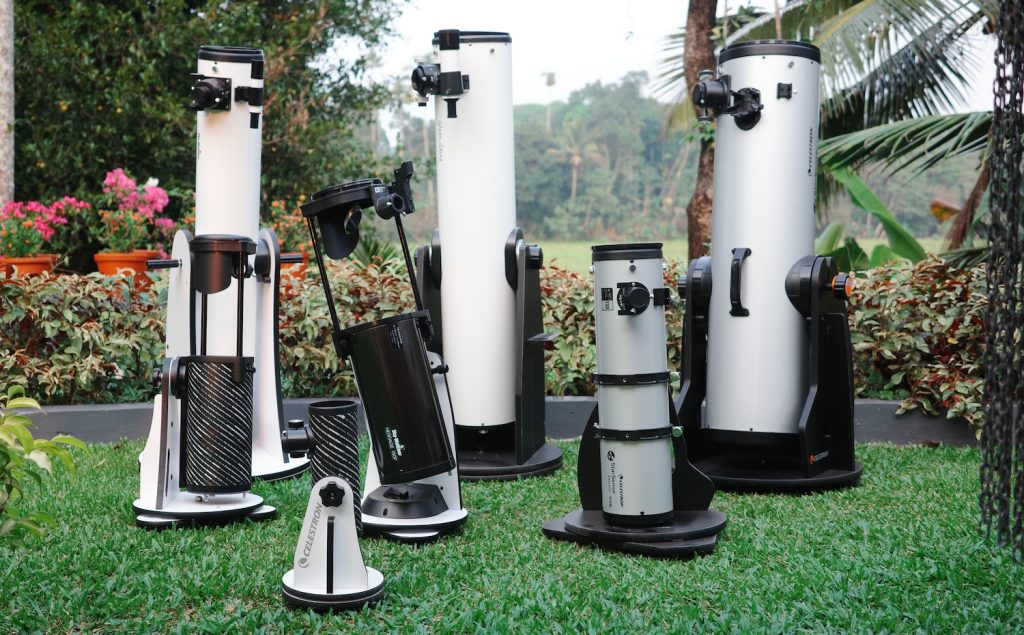
- While refractors are what many picture as the classic ideal of a telescope, they are by far the most expensive and usually the least practical of the more mainstream telescope types. The more affordable achromatic refractors can deliver nice views of bright objects but suffer from chromatic aberration that blurs close-up views of the Moon and planets, especially if the tube is shortened to a convenient length or as the aperture size increases.
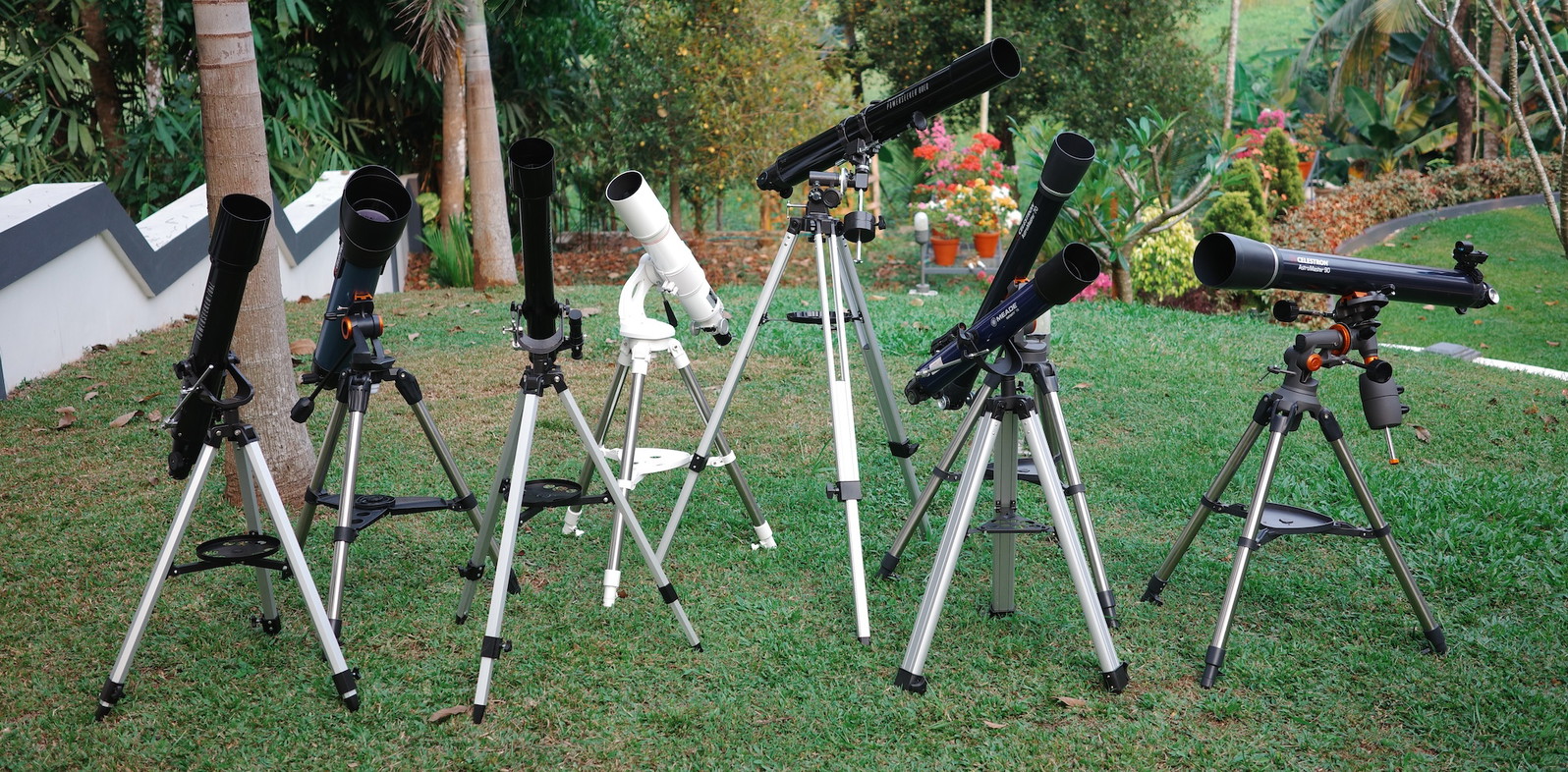
- Apochromatic refractors—ED doublets and triplets—are great astrophotography telescopes but are rarely affordable, nor are they usually made for beginners. If you’re seriously considering doing long-exposure astrophotography, Schmidt-Cassegrains and properly mounted Newtonian reflectors are also decent choices for the job.
- Consider a catadioptric telescope if the portability or maintenance of a Dobsonian is a concern for you. Maksutov-Cassegrain telescopes offer extremely sharp images, are very compact, and don’t frequently need their optics aligned (collimated), while Schmidt-Cassegrains offer better astrophotography capabilities and typically go up to larger aperture sizes than commercial Maksutovs. These telescopes are often bundled with compact computerized mounts, too.
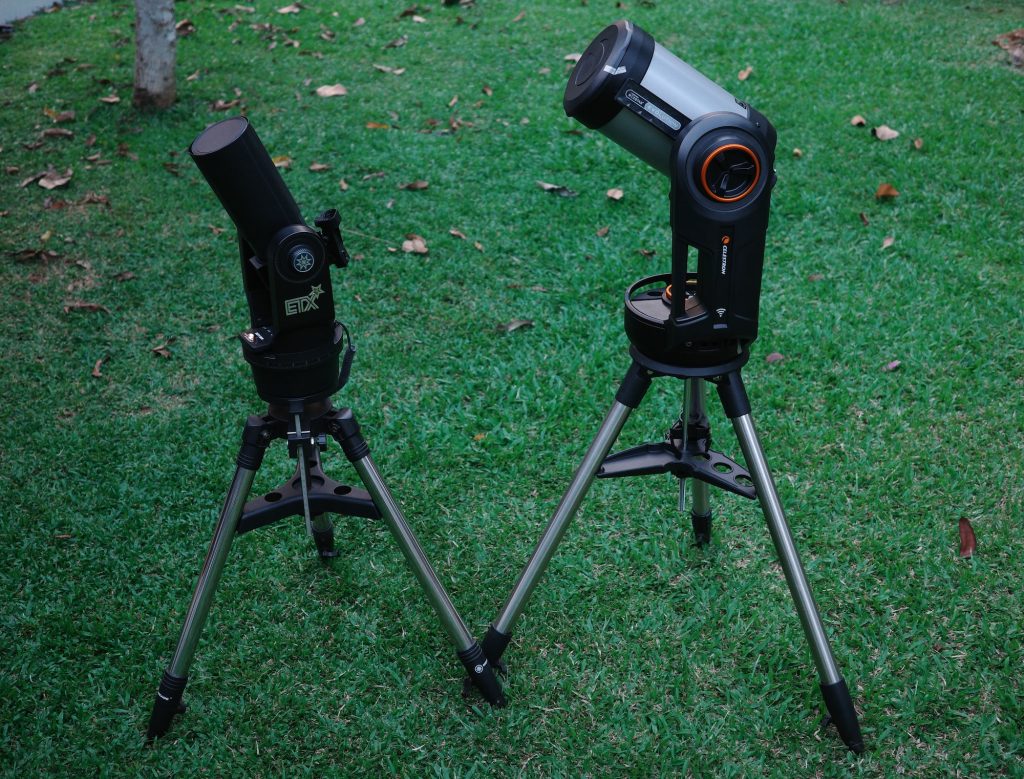
Summarizing Our Recommended Telescopes Individually
Jump to the summary of:
- Below $200: Sarblue Mak60 or SarBlue Mak70
- In $200 – $300: Sky-Watcher Heritage 130P
- In $300 – $400: Sky-Watcher Heritage 150P
- In $400 – $550: Sky-Watcher Virtuoso GTi 150P (The Best-Value Computerized Scope; Buy from High Point Scientific)
- In $550 – $900: Apertura AD8 Dobsonian (The Best-Value Telescope; Buy from High Point Scientific)
- In $900 – $1200: Apertura AD10 Dobsonian (The Hobbyist’s Pick; Buy from High Point Scientific)
- In $1200 – $1500: Apertura AD12 Dobsonian
- In $1500 – $2000: Sky-Watcher 12” FlexTube Collapsible Dobsonian
- In $2000 – $2500: Celestron NexStar Evolution 8 (The Best Balance Between Features & Aperture)
- Best Value-for-Money Schmidt-Cassegrain: Celestron NexStar 6SE ($1000 Tripod-Mounted, Non-Dobsonian)
- Best Smart Telescope: ZWO SeeStar Smart Telescope
- Best Solar Telescope: Lunt 40mm f/10 B500 Dedicated H-alpha Solar Telescope
In $200-$300: Sky-Watcher Heritage 130P
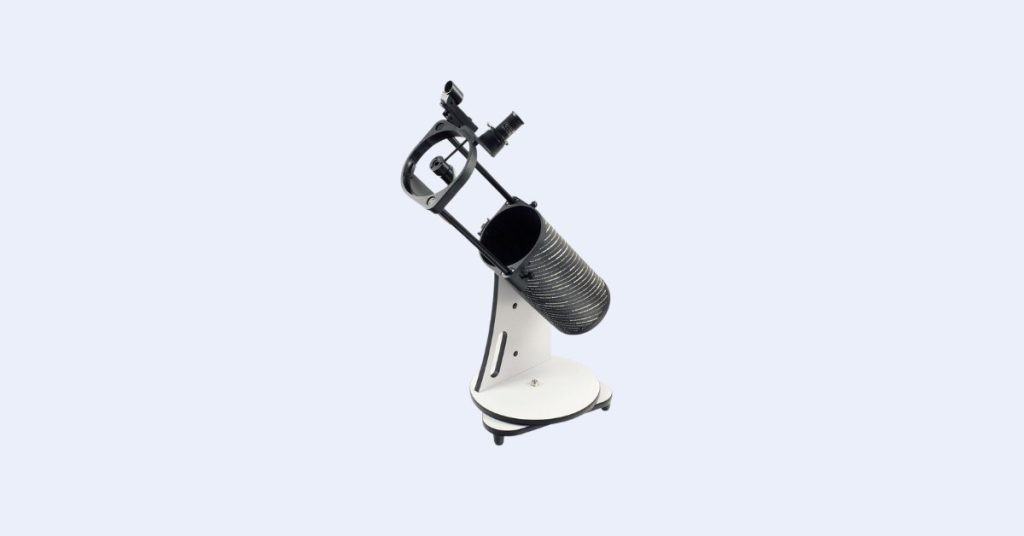
- Easier collimation than smaller tabletop scopes
- Collapsible tube for portability
- High-quality included accessories
- Type of telescope: Dobsonian Reflector
- Aperture: 130mm (5.1 inches)
- Magnification: The Heritage 130P comes with two 1.25” eyepieces—25mm and 10mm “Super” Konigs yielding 25x and 65x magnification, which are just fine to start with—though you may want more eyepieces such as a 6mm “goldline,” which would provide 108x, more appropriate for viewing planets and other small targets like globular star clusters.
- Mount: Tabletop Dobsonian
The Sky-Watcher Heritage 130P has a collapsible tube, making it just as portable as a smaller instrument. The Heritage 130P weighs significantly less than a solid-tubed scope of its size (think Celestron’s StarSense 130mm Dobsonian), which makes finding a sturdy table, bar stool, or crate to set it on a bit less of a challenge.
You can just barely start to resolve globular clusters into stars with the 130P on a good night, and it’ll show you dark markings on Mars and the shadows of Jupiter’s moons a bit better than with a smaller scope.
The StarSense 130mm Dobsonian provides essentially the same performance and optics as the Heritage 130P in a solid tube, which adds weight but decreases complexity.
The GSKYER 130mm EQ’s mounting is not our favorite, but it also features similar optics, a nice set of eyepieces, and a well-designed focuser, though quality control can be questionable.
Best Value Manual Tabletop Dobsonian
In $300-$400: Sky-Watcher Heritage 150P
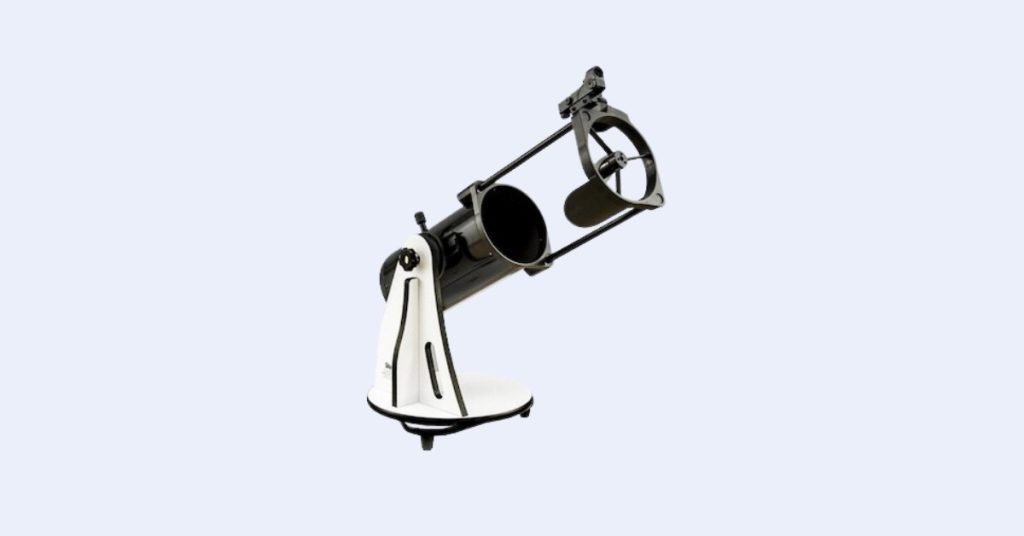
- Large 6” aperture without inconveniences of a full-sized tripod or base
- Collapsible tube for portability
- Not much heftier than a smaller scope
- Type of telescope: Dobsonian Reflector
- Aperture: 150mm (6 inches); the 20mm of additional aperture compared to a 130mm telescope provides 33% more light gathering power and and 15% more resolution
- Magnification: The Heritage 150P includes 1.25” diameter, interchangeable 25mm and 10mm focal length eyepieces providing 30x and 75x – and it can handle up to around 300x magnification, so some shorter focal length eyepieces for higher power on clear and steady nights would be appropriate. Aiming the 150P is accomplished with the provided red dot finder.
- Mount: Tabletop Dobsonian
The Sky-Watcher Heritage 150P is pretty much just an upscaled version of the popular Heritage 130P. The 150P features the same collapsible tube as the 130P allowing it to fit in even the smallest of spaces, and works best when situated atop a surface such as a bar stool or milk crate.
With a 6” telescope you can start to resolve globular star clusters into individual components, see dust lanes in galaxies, and spot Neptune’s large moon Triton, among other things.
Best Value Computerized Telescope
In $400-$550: Sky-Watcher Virtuoso GTi 150P
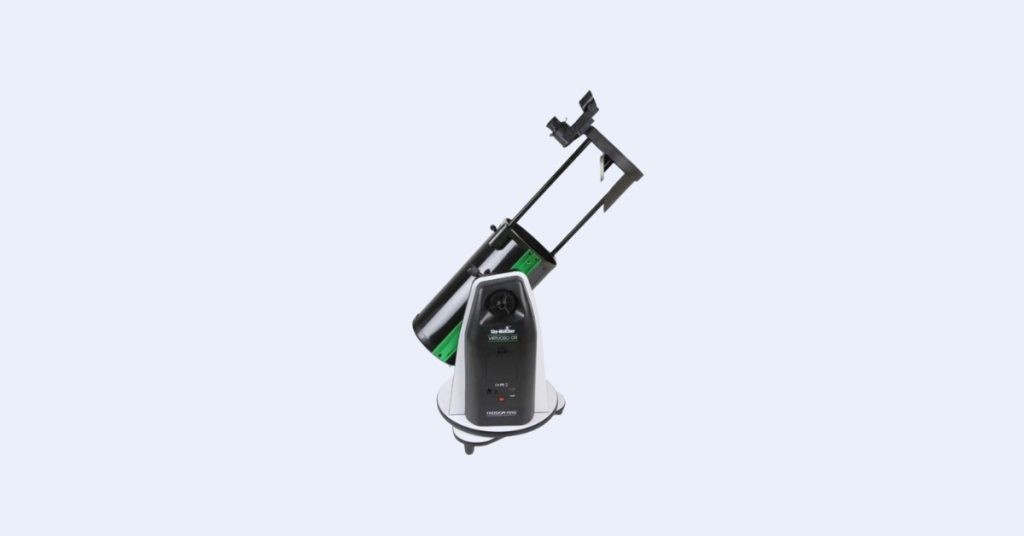
- 6” of aperture with fully motorized GoTo/tracking, all in an affordable and compact package
- Able to be used manually as well, even when powered on
- Otherwise same great features as Heritage 150P
- Type of telescope: Dobsonian Reflector
- Aperture: 150mm (6 inches)
- Magnification: As with the Heritage 150P, you get two 1.25” Super eyepieces (25mm/10mm providing 30x and 75x respectively) with a red dot finder.
- Mount: Computerized Tabletop Dobsonian. The scope is meant for tabletop use.
The Sky-Watcher Virtuoso GTi 150P uses the same tube, optics, and tabletop Dobsonian mount as the Heritage 150P, but adds Sky-Watcher’s unique GTi GoTo system to the mix.
The Virtuoso GTi mount can be used as a manual Dobsonian exactly like the standard Heritage 150P, or powered on for full automatic GoTo and motorized tracking controlled by your smartphone, with either the free SynScan app or another app like SkySafari. You can even aim the scope manually while the mount is powered on with no ill effects on the tracking or pointing accuracy of the motorized GoTo features.
The Virtuoso GTi 150P is our top pick among affordable GoTo telescopes and offers some of the best value for money of any scope under $700 USD. As such, it’s little surprise that it’s also our top pick among the category of GoTo reflectors.
There is a good value 6” f/8 full-sized Dobsonian available at the same price range of the Virtuoso GTi 150P if you must have one: Apertura AD6. It is far bulkier than the little 150P but still an excellent choice.
Best Value Telescope Overall
In $550-$900 – Apertura AD8 Dobsonian
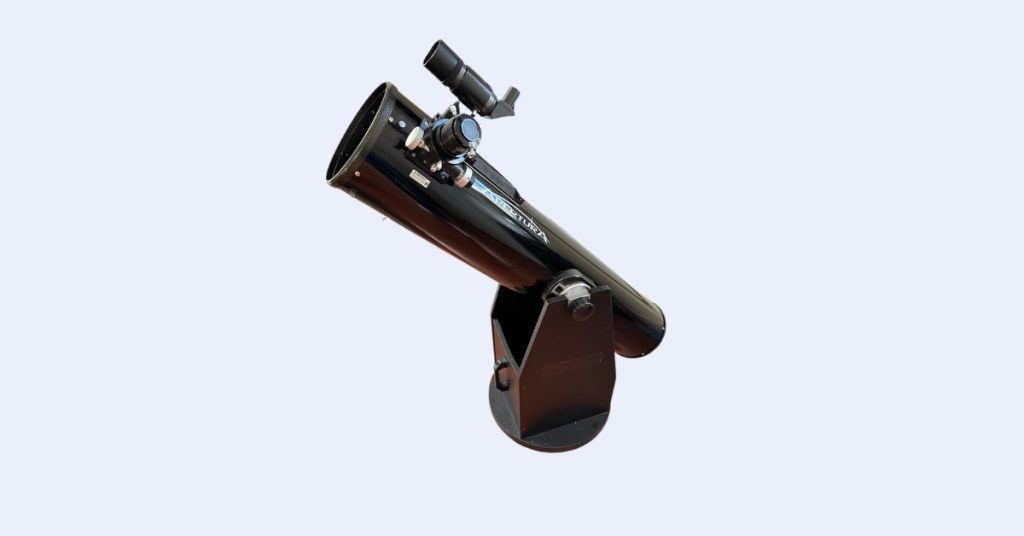
- Large 8″ aperture and easy collimation
- No significant portability difference from 6” Dobsonians
- No table or crate needed
- Included accessories provide excellent value
- Extremely good value
- Type of telescope: Dobsonian Reflector
- Aperture: 200mm (8 inches). An 8” telescope shows far more celestial objects and detail than a 6” while an 8” f/6 Dobsonian like the AD8 is negligibly heavier or bulkier compared to a standard 6” f/8 Dob. You get double the light gathering power of a 6” scope and 33% more resolution.
- Magnification: The AD8 comes with two eyepieces: a 2” 30mm SuperView (40x) and a 1.25” 9mm Plossl (133x). We would highly recommend an additional 6mm “goldline” eyepiece to get the best planetary views the scope can offer.
- Mount: Dobsonian. The AD8 sits on the ground and pivots on smooth roller bearings with friction and balance adjustments.

An 8” Dobsonian is a much bigger telescope than the earlier listed small tabletop Dobsonians, but they come with significant advantages in capability and use—double the light gathering of a 6” and with a 2” focuser too.
The scope is certainly a lot less compact than a 6” or smaller tabletop unit, but you’re rewarded with double-that’s right- double-the light gathering ability, 33% more resolving power, and a sturdy, freestanding telescope that can last a lifetime.
With an improved dual-speed focuser with a micro-adjusting knob, a quality 9×50 finderscope, and even an included laser collimator, the Apertura AD8 is well worth the money. The AD8 even has a cooling fan for cold nights!
The AD8 is the best 8” Dobsonian available, along with our top overall pick for a beginner telescope, and nothing beats the sheer value in its price range; some of the other 8” Dobsonians from Orion or Sky-Watcher cost a little less but just the dual speed focuser easily is worth more than double the price increase of the AD8. The Apertura AD8 is the telescope I most often recommend to beginners.
The average person can handle an 8” Dobsonian, and the gains over a 6” are certainly worth the price and inconvenience. An 8” telescope will last you a lifetime.
The Zhumell Z8 and Orion SkyLine 8 are identical to the AD8 in every way should you not be able to find one.
Best Value 10″ Dobsonian
In $900-$1200: Apertura AD10 Dobsonian
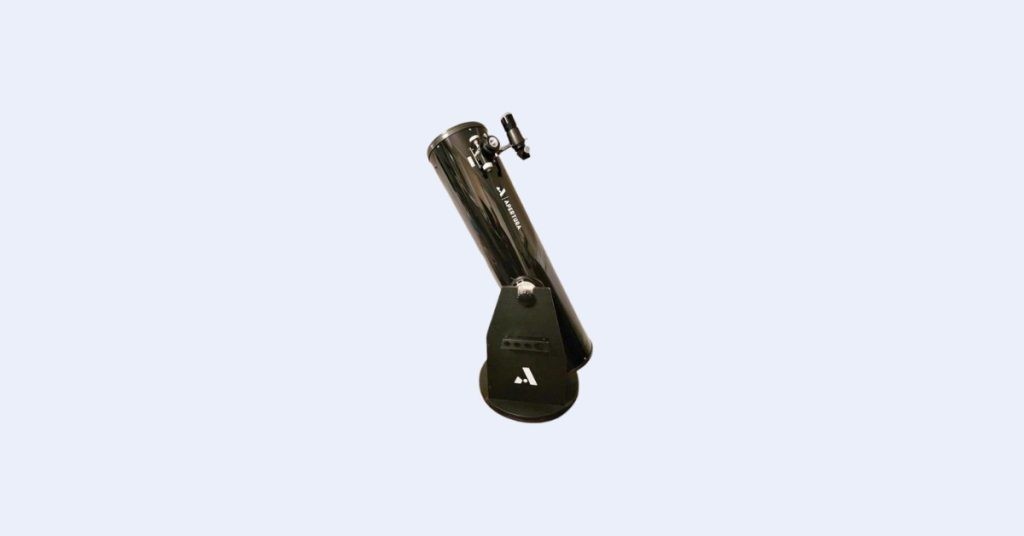
- More performance than an 8” in essentially the same size package
- Excellent included features/accessories
- Still fairly portable
- Extremely good value
- Type of telescope: Dobsonian Reflector
- Aperture: 250mm (10 inches). The 10″ offers you 56% more light-gathering power and 25% more resolution compared to an 8″. The AD10 will easily reveal faint Solar System targets like the moons of Uranus under dark skies, and can resolve the Encke Gap in Saturn’s rings or surface details on Jupiter’s moon Ganymede under good seeing conditions. You’ll be able to start resolving spiral arms in galaxies like M51 and M33, and most of the objects in the Messier catalog are downright easy to see.
- Magnification: Comes with two eyepieces: 2″ 30mm focal length “SuperView” (42x magnification) and a 1.25″ 9mm Plossl (139x magnification).
- Mount: Dobsonian
The Apertura AD10 is only slightly less portable than the Apertura AD8 and 8” Dobsonians. While it’ll still fit in an SUV, however, keep in mind that the tube and base are big enough that they’re getting a bit awkward to handle—though nowhere near as much so as the Apertura AD12.
The AD10 has the same features, accessories, focal length, and, of course, great value for the money as the AD8; the only difference is the slightly wider tube and larger aperture.
A 10” is a serious telescope and a size that many people choose to stop at. You’re unlikely to run out of interesting things to see with it if you have access to clear skies, and transporting the AD10 in most vehicles isn’t much of a problem.
The Celestron StarSense Explorer 10” Dobsonian is a great option if you want a slightly more lightweight and convenient instrument than the AD10 and don’t mind purchasing accessories separately.
Best Value 12″ Dobsonian
Best $1200-$1500: Apertura AD12 Dobsonian
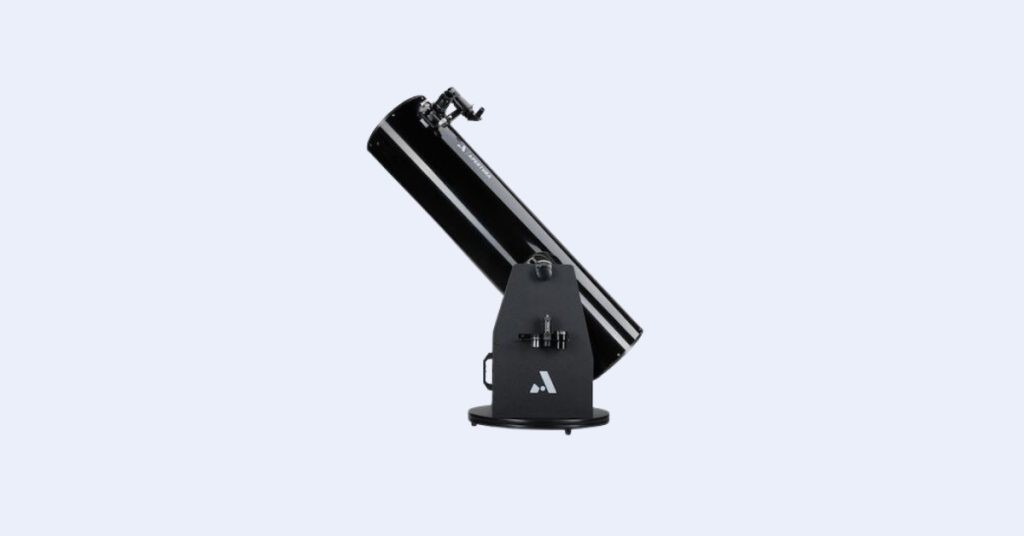
- Huge aperture
- Great accessories
- Simple to set up and use if you can accommodate its massive size
- Type of telescope: Dobsonian Reflector
- Aperture: 300mm (12 inches). A 12” Dobsonian easily shows Pluto, resolves even fairly dim globular clusters, and shows incredible detail in many galaxies, even from the suburbs. Jupiter’s moon Ganymede may even show a slight dark marking called Galileo Regio. Uranus’ moons are fairly easy to spot.
- Magnification: Comes with two eyepieces: a 2” 30mm focal length “SuperView” (50x magnification) and a 1.25” 9mm Plossl ocular (167x magnification)
- Mount: Dobsonian
An upscaled version of the AD8 and AD10, the Apertura AD12 offers colossal light gathering power. A generation ago, only a professional or very rich amateur could own a telescope this large!
Weighing only 75 pounds, the AD12 is not a lightweight telescope. Its 14” wide tube is rather awkward to carry too, but don’t fret! You can fix this with homemade or aftermarket straps. Or just put the whole scope on a hand truck or dolly. That being said, the AD12 will still fit in most sedans and SUVs, though compact car owners may be in trouble.
We’d recommend getting a smaller scope to complement the Apertura AD12, just to make sure you’re hooked before bringing this beast into your home. A smaller scope would help too, for nights when it isn’t worth hauling the big scope out. But if Apertura AD12 is in your budget, and if you can get this scope to where you want it, do it. There’s nothing quite like the power of a 12 inch Dobsonian.
If you’d rather stick with a more compact scope, in addition to more-expensive 12” and 14” collapsible/truss tube Dobs the 10” Truss Tube from Explore Scientific and the 8” GoTo FlexTube Dobsonian from Sky-Watcher are great picks, as are standard 8” and 10” Dobs at lower prices.
Best Value 12″ Collapsible Dobsonian Telescope
Best $1500-$2000: Sky-Watcher 12” FlexTube Collapsible Dobsonian
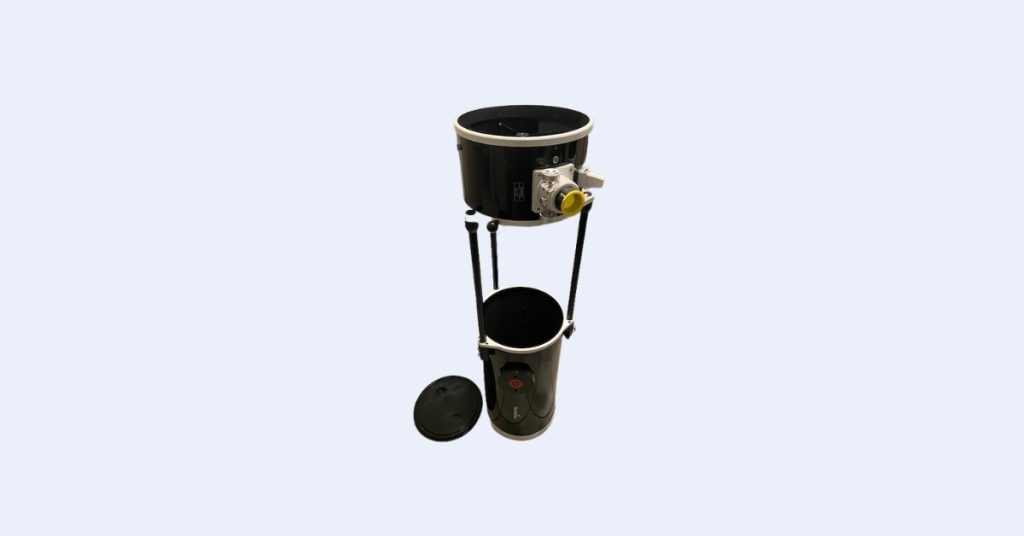
- About as portable as a standard 8” or 10”
- Easy to set up and use
- Big, bold, and bright views as to be expected with any 12” Dob
- Type of telescope: Dobsonian Reflector
- Aperture: 300mm (12 inches).
- Magnification: Comes with two “Super” Plossl 1.25” eyepieces: a 25mm providing 60x magnification and a 10mm providing 150x.
- Mount: Dobsonian
While the smaller FlexTube Dobsonians provide little advantage over their solid-tubed counterparts – especially for the price – the 12” FlexTube model from Sky-Watcher is a far less bulky option than a solid-tubed scope like the Apertura AD12 for space-conscious users.
The 12” FlexTube’s optical tube assembly collapses in seconds with the turn of a few levers/knobs to a shorter length than a standard 8” or 10” scope.
However, you don’t get as many features and amenities by default as Apertura’s excellent scopes, and additional upgrades like a shroud will be needed for the open tube.
The Explore Scientific 12” Truss Tube Dobsonian, as well as the Sky-Watcher 10” FlexTube GoTo, are also great picks at this price range for a high-quality, high-performance and portable Dobsonian.
Best High End Computerized Compact GoTo
In $2000 – $2500: Celestron NexStar Evolution 8
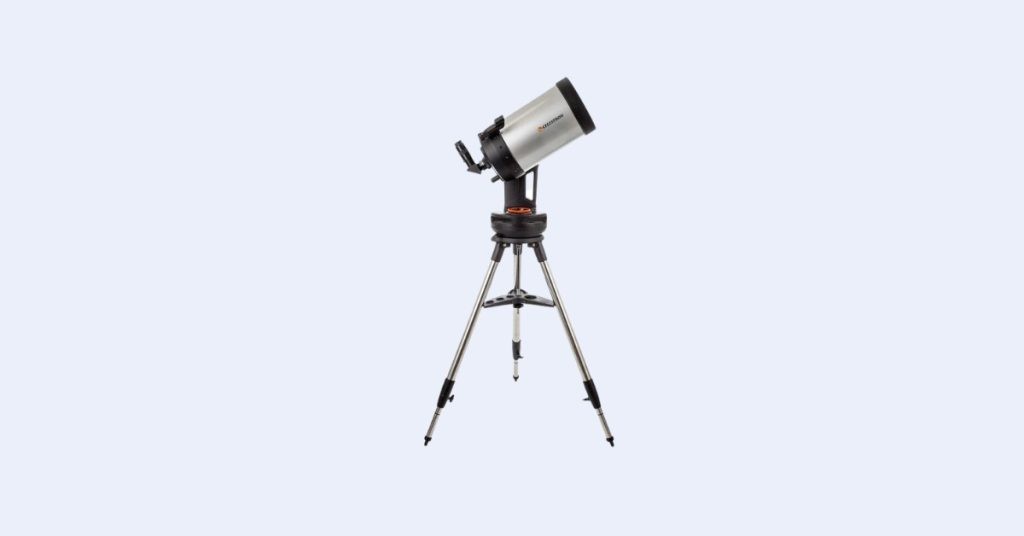
- Compact Schmidt-Cassegrain optical tube along with built-in battery and WiFi make for a convenient setup
- High-quality tracking and some imaging capabilities too
- Sufficient aperture for good views
- Type of telescope: Schmidt-Cassegrain
- Aperture: 200mm (8 inches)
- Magnification: The Evolution 8 comes with two eyepieces: a 40mm plossl (51x) and a 13mm Plossl (156x). While these will be fine to start out with, we’d highly recommend obtaining a 2” diagonal and low-power 2” eyepiece as well as a high-power ocular to get the widest vistas and the highest powers usable with NexStar Evolution telescopes.
- Mount: Altitude-Azimuth
The NexStar Evolution 8 is incredibly easy to operate with its provided hand controller or over WiFi, features fully motorized GoTo and tracking, and even has its own built-in rechargeable battery for plug-and-play use.
The 8” model is our favorite, offering better performance than the 6” with a minimal increase in bulk; the 9.25” has some issues that make it less-than-ideal, especially for beginners.
Being a Schmidt-Cassegrain catadioptric design, the Evolution’s main drawback is the somewhat narrow maximum field of view compared to a similar sized reflecting telescope. However, the computer functions more than make up for this.
In addition to the smaller/cheaper 6” and more well-accessorized 8” EdgeHD/StarSense models of the NexStar Evolution, there are a wide variety of other options to consider in this price range including computerized 12” and 10” Sky-Watcher Collapsible Dobsonians, and if you’re interested in astrophotography an a la carte OTA and mount are also worth considering.
Some Other Good Telescope Choices
Best Budget Schmidt-Cassegrain: Celestron NexStar 6SE
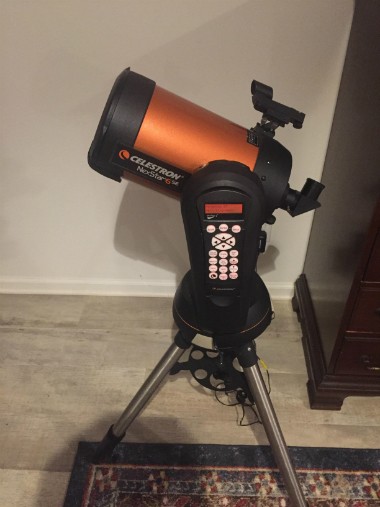
The Celestron NexStar 6SE isn’t perfect, but it’s a capable and compact GoTo telescope. It’s a 6” (150mm) Schmidt-Cassegrain telescope with a motorized, tracking GoTo mount.
The 6SE doesn’t have built-in WiFi by default, but you can purchase a dongle to operate it wirelessly if you wish.
The compact design of the 6SE and its tripod make it ideal for travel or fitting into tight spaces, but this scope cannot be aimed manually, and its 1500mm focal length somewhat limits the field of view. For more information, check out our dedicated review of the 6SE.
Best Smart Telescope: ZWO SeeStar Smart Telescope
In the evolving world of telescopes, the rise of “smart” telescopes has bridged the gap between traditional stargazing and technology.
Our top pick in this category is the ZWO SeeStar, but before you dive into the world of smart telescopes, there are some nuances to consider.
Using a smart telescope is not the same as looking through the eyepiece of a traditional telescope. The digital screen displays processed images of celestial objects, which might not give the raw, immersive feel of peering into the vastness of space directly.
And conversely, while the ZWO SeeStar and similar devices provide impressive visuals, they do not match the image quality of dedicated astrophotography setups. The images produced by these instruments are generally meant for quick, real-time viewing rather than high-resolution captures that can be enhanced and edited.
Being relatively new to the market, smart telescopes, including the SeeStar, often come with their share of teething issues. Users might encounter software bugs, limitations in celestial object databases, or occasional hardware glitches. Over time, as manufacturers receive feedback and release updates, many of these issues are likely to be resolved, and better products will likely come out. But for now, we would not particularly recommend any of these devices.
Best Solar Telescope: Lunt 40mm f/10 B500 Dedicated H-alpha Solar Telescope
Lunt’s 40mm hydrogen-alpha solar telescope replaces the former LS35 as the smallest unit in Lunt’s lineup. This telescope, like any dedicated hydrogen-alpha solar telescope, will show you not only sunspots but also flares, prominences, and other features in the upper atmosphere of our nearest star.
However, it should be noted that this telescope will need a suitable mount, tripod, and eyepieces, which must be purchased separately.
Our Best Solar Telescopes article and guide to viewing the Sun and eclipses contain further information on what’s needed to view the Sun close-up and what’s right for you.
How did I picked the telescopes?
I have worked with, collectively, thousands of telescopes and hundreds of brands/models, including all of the top gear available on the market today. My selections are based on the following:
- Manufacturer reputation and service
- Performance for the money
- Overall mechanical/build quality
- Optical quality
- Included accessories
- Available competitors with similar specs
Telescope Buying Advices: The Knowledge Hub
The first thing you want to do is figure out what you really want out of your telescope. Consider:
- Where will you use it?
- Where will you store it?
- How much weight can you carry comfortably?
- How will you find the things you want to see?
- Is this for home use, or will you frequently put it in your car?
- Will you want to take it on an airplane?
You don’t have to be a technical engineer to buy an awesome telescope, but if you understand a few concepts and terms like the ones below, you’ll be fine.
- Optical Tube Assembly: This is the light-gathering part of the telescope. Common forms are refractor, reflector, Schmidt-Cassegrain telescope (SCT), and Maksutov-Cassegrain (MCT).
- Aperture – This is the diameter of the front lens or rear mirror of the optical tube. This is usually stated in millimeters, mm, or inches and may be noted as 150 mm or 6” in the specifications. This is the key specification for judging the telescope’s ability to show you dim and distant planets and deep-sky objects. In general, the larger the aperture, the better.
- Focal Length: This is a measure of the optical path within the optical tube. Using this, you can determine the magnification that will be provided by any given eyepiece.
- FL scope/FL eyepiece = magnification.
- Focal Ratio: This is simply the focal length divided by the aperture. It tells you about the physical size of the scope. A low-focal-ratio optical tube will be shorter than a high-focal-ratio optical tube with the same aperture and the same design.
- Focuser – This moves the eyepiece in or out along the light path to bring the image into focus. Common sizes are 1.25 inch and 2 inch which determine the size of the diagonal or eyepiece that can be accepted. Some are single-speed and some are dual-speed, with a quick focus and a slow focus knob that allow much finer adjustments, which can be helpful when using high magnification.
- Diagonal – These are placed into the focuser and receive the eyepiece in refractors, SCTs, and MCTs. Common sizes are 1.25 inch and 2 inch which determines the diameter of the eyepiece that can be accepted. The diagonal turns the direction of the eyepiece either 45 degrees or 90 degrees to provide a more comfortable viewing angle. The 45-degree models are usually for daytime use when the optical tube is fairly level for use as a spotting scope. The 90-degree diagonals, also called star diagonals, are better for astronomy as the optical tube is usually pointed high in the sky.
- Mount – This is what holds the optical tube and allows you to point it effectively. Common types are Equatorial, and AltAz which work similar to a camera tripod. The mount is a critical part of the telescope system. If the mount is wobbly, the image will shake every time you try to focus or when there is a breeze. If the mount is wobbly, it may be difficult to track your target as you move the optical tube to account for the rotation of the earth. A good optical tube on a poor mount provides a frustrating experience.
- PushTo or DSC Mount: There are sensors in the computer control system—or inside your smartphone—that track the position of the mount. An initial alignment procedure is done so the software knows the location of some reference stars. After that, you put your target into the computer or app, and it tells you where to point the scope to see that target.
- GoTo Mount: Similar to the PushTo mount, there are sensors that know the position of the mount. However, the GoTo mount has motors that are controlled by the computer, usually a handset. After a quick initial alignment, so the mount knows the date, time, and location, you put your target choice into the computer, and the computer uses the motors to turn the mount so that the target can be seen in the eyepiece. As the GoTo mounts are motorized, the computer uses the motors to track the target as the Earth rotates, whereas the other mounts require you to move the optical tube to track the target yourself.
- Eyepiece: This is an optical device that goes into the focuser or diagonal. The optical tube gathers light, but it is the eyepiece that provides the magnification. Eyepieces come in various focal lengths, each providing a different magnification according to the focal length of the optical tube according to the formula: Focal Length Optical Tube/Focal Length Eyepiece = Magnification. Therefore, a 10 mm eyepiece will provide different magnifications depending on the focal length of the telescope. Eyepieces are standardized on 1.25” and 2” diameters. Which size you can use is determined by the focuser and diagonal.
There are several different types of telescopes, with the most common being refractor, reflector, and catadioptric telescopes.
- Refracting telescopes usually provide the best image for their apertures but are usually pricey. They’re seldom available with large apertures. Inexpensive ones do have a fair amount of chromatic aberration, though, thanks to the achromatic lens design they use. Refractors seldom require maintenance and do not usually need to cool down before use.
- Reflector telescopes provide the most bang for your buck in terms of light-gathering power and resolution, but they require frequent alignment of mirrors and may need to cool down before being used. Unintentionally, most of the recommended scopes in this guide are reflectors.
- Catadioptric telescopes are moderately expensive but are much more compact than most equivalent-sized refractors or reflectors. They do require periodic maintenance and need to cool down as well, but not as much as most reflectors.
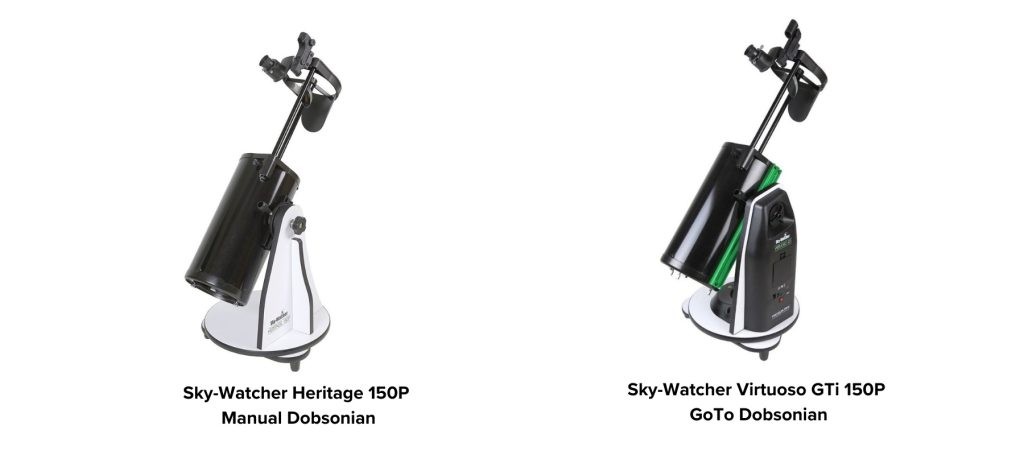
While some telescopes come equipped with computerized assistance for tracking celestial bodies, we often advocate for manual scopes. Though computerized options might offer convenience, they typically need a power supply and can have longer setup times. Being proficient with a star chart can be more advantageous.
Some computerized telescopes are referred to as “PushTo”, which means that they have passive encoders or utilize your smartphone to keep track of your location in the sky and provide assistance but do not have motor drives. The more common “GoTo” telescopes use motors to track objects and automatically point at them. This may sound great, but the electronics of these telescopes are heavy, require lots of power, and, of course, necessitate leveling the telescope and going through an alignment procedure.
Many GoTo telescopes also run on technology that has not changed much since the 1990s, using antiquated hand controllers that are slow to respond and hard to navigate. This can make setting them up quite a time-consuming and frustrating process. A lot of GoTo telescopes also use simple, cheap encoders to keep track of their position. This means that they will not be able to accurately point at or track objects if they are bumped or manually aimed around the sky. Newer GoTo telescopes use slip clutches, which allow you to seamlessly switch between manual and electronic pointing, or just avoid powering the mount on altogether. Many can also connect to your smartphone or tablet for operation via an app. We do not typically recommend GoTo telescopes or mounts that lack slip clutches and/or WiFi compatibility.
Nonetheless, the prime disadvantage of a computerized telescope is its cost. Simply put, you are putting money into electronics that could otherwise go towards a better telescope, eyepieces, filters, gasoline to get to a dark sky site, or a myriad of other practical expenditures to boost your observing experience.
The money you’re spending on a telescope should go as much towards the aperture (size of the objective lens or mirror) as possible. When you’re spending only a few hundred dollars on a computerized telescope, half your money is going to go to the drive systems and controller, and as a result, you get rather little actual “telescope” for your money. If you live in the city, you’ll definitely want to prioritize aperture. A small telescope will show little under severe light pollution, but in general, you’re going to want to get as far away from cities as you can when you skywatch anyway. Weigh these carefully against the additional expenditure that you’d spend on a computerized instrument.
There’s no right or wrong answer when it comes to the level of technology that you’re comfortable with, though, and both kinds of scopes (tech-included or not) have their own pros and cons, so make sure to really think about what you want out of your scope before making any kind of purchase.
When you’re in the market for a telescope, it’s important to know what you’re getting for your money. The price of a telescope can be indicative of its features, build quality, and the clarity of the images it produces. Here’s a breakdown of what you can expect in various price ranges:
$100 Range
- Quality: Most of the telescopes in this price range are little more than cheap toys, with a few exceptions (small, usually tabletop Dobsonian-mounted Newtonian reflectors).
- Expect: No more than 102mm (4”) of aperture; some compromises on accessories; and possibly on optical quality. Anything on a tripod at this price is going to be tiny, wobbly, or both.
$200 Range
- Quality: About the minimum you can spend and get a telescope with decent optics, mechanics, and accessories from the start without any aftermarket purchase or modifications.
- Expect: 4-5” aperture at most. Good tripod-mounted options do exist in this price range, but they are not exactly our first choice.
$300 Range
- Quality: Any good telescope in this price range usually comes with reasonably good accessories and less plastic, and you might actually be able to find an acceptable tripod-mounted instrument around this price. Still mostly manual telescopes.
- Expect: 4-6” aperture reflectors, small (<4”) refractors, and Maksutov-Cassegrain telescopes of acceptable quality.
$500 Range:
- Quality: Not much different from the $300 range. Some plastic, 6” telescopes at most.
- Expect: Acceptable GoTo telescopes.
$750 Range:
- Quality: Pretty much no more plastic, some ED refractors, 8” Dobsonians, 5-6” catadioptrics.
- Expect: Decent GoTo/PushTo mounts/telescopes
$1,000 Range:
- Quality: No plastic, decent included accessories, if any
- Expect: 10-12” Dobsonians, computerized German EQ mounts, 6” Maksutovs and achromats, 8” SCTs, 4” ED refractors and even some triplets
$1,500 Range:
- Quality: It’s hard to find a product at this price range that we don’t recommend.
- Expect: 5” triplet or high-end doublet refractors; 9.25-10” SCTs; 7” Maksutov-Cassegrains, 12-14” Dobsonians. Full-sized GoTo equatorial mounts that are actually good for deep-sky astrophotography with telescopes.
$2,500 Range:
- Quality: High-quality optics across all types
- Expect: 14-16” Dobsonians, 11-12” SCTs, some nice 6” and smaller apochromatic refractors, and nice heavy-duty GoTo equatorial mounts.
$5,000 Range:
- Quality: Usually, a custom order kit at this price
- Expect: 16-20” Dobsonians, 11-14” SCTs, 6” and even 7” high-end refractors, and 7-8” Maksutovs. High-end GoTo mounts of all sorts
As with many products, you generally get what you pay for with telescopes. However, even at lower price points, you can have a satisfying stargazing experience. It’s essential to balance your budget with your astronomical goals and consider the features most important to you. Remember, the best telescope is the one you use the most, regardless of its price!
However, you should always avoid going for exceptionally cheap telescopes priced under $100 or so new, as these are across-the-board low-quality products that are either scams or toys. For those priced below $300–500, manufacturers tend to compromise on certain aspects. Remember, a quality telescope is an investment meant to last a lifetime, so if possible, be prepared to invest a bit more for an enjoyable experience.
One aspect that often gets aggressively marketed by manufacturers to beginner astronomers is high magnification. It’s common to come across telescopes that promise staggering magnification levels, sometimes even exceeding 500x or 1000x. To the uninitiated, these numbers might seem incredibly appealing. After all, who wouldn’t want to see celestial objects up close? However, there’s more to magnification than meets the eye.
Our article “Telescope Magnification Limits: How Much Is Too Much?” goes into more detail, but the summary below should steer you far away from the shysters offering these products and give you an understanding of why most observations are done at fairly low power. Here are some magnification related myths.
- High Magnification ≠ Better Views: One might assume that higher magnification always translates to better views. In reality, while magnification does make objects appear larger, it also spreads out their light, which can result in a dimmer, less detailed view.
- Atmospheric Limitations: Earth’s atmosphere isn’t always stable. Air turbulence can distort telescopic views, and this distortion is magnified as you increase the magnification. On most “good” nights, atmospheric conditions will limit the usable magnification to around 200–300x, regardless of the telescope. On a bad night, even 100x may be somewhat fuzzy. Nights with conditions allowing a stable image at powers above 500–600x are rare, and you need quite a big telescope to provide enough resolution to support these powers.
- Optical Quality: As magnification increases, any imperfections in a telescope’s optics, or their alignment, become more pronounced. In many low-quality telescopes that tout high magnification, the resultant image is often blurry or distorted. High magnifications above 40x per inch of aperture also tend to expose the errors in your own eyeball’s optics, revealing “floaters” that seem to get in the way along with your eyelashes; this is particularly problematic with smaller telescopes.
- Scams to Watch Out For: Beware of cheap telescopes that heavily promote their high magnification as their main selling point. This emphasis is often a clear indicator of an inferior product. Reliable telescope manufacturers and sellers understand the limitations and realities of magnification and focus on other essential aspects, such as aperture size and optical quality.
Practical Magnification Usage
For most observational purposes, astronomers seldom use very high magnifications. Many celestial wonders, like galaxies, star clusters, and nebulae, are best appreciated at lower magnifications, which offer wider fields of view so you can take in the whole object at once. Furthermore, lower magnifications provide brighter images by condensing the light from these distant objects into a smaller area. This brightness is crucial when observing faint objects, ensuring they are visible against the dark backdrop of the night sky.
While the Moon, planets, and other small/bright targets like double stars and planetary nebulae can benefit from higher magnifications, there’s a sweet spot where detail is maximized without sacrificing image clarity or losing too much brightness. This balance usually doesn’t require the highest possible magnificatio
If you are fortunate enough to observe from home or otherwise store your telescope at a fixed location, you are lucky. Most astronomers tend to stargaze at locations further away from city lights whenever possible or otherwise have physical obstructions or human factors (such as neighbors with bright “security” lights) to contend with when observing at home. This latter category includes myself, despite the fact that I am fortunate enough to be able to see the Milky Way’s faint glow over my backyard.
If the telescope in question is heavy and has to be taken out of a garage or shed to be used, we recommend a dolly that stays under the telescope when it is in use. Larger Dobsonians can be strapped to a simple hand truck or have wheelbarrow handles simply bolted onto the side and rolled upright in one piece, then removed. For other telescope types, it’s extremely unlikely that you can’t just dismantle them into lightweight constituent components. A dolly should only be used as a last resort as they are expensive, reduce stability during operation, add to the height of your telescope, and could easily get caught on an obstacle and tip your telescope over while rolling it around.
Contrary to what many believe, most telescopes don’t actually require dedicated carry cases. While they might seem like a good protective measure, they are often only available as custom builds, especially for larger instruments. Many smaller telescopes will take up dramatically more space inside a case, hindering portability, while the cases themselves cost quite a bit of money. And a cheap case is little more than decoration, offering little added protection during transport and lacking the advantages of being airtight when stored for long periods of time.
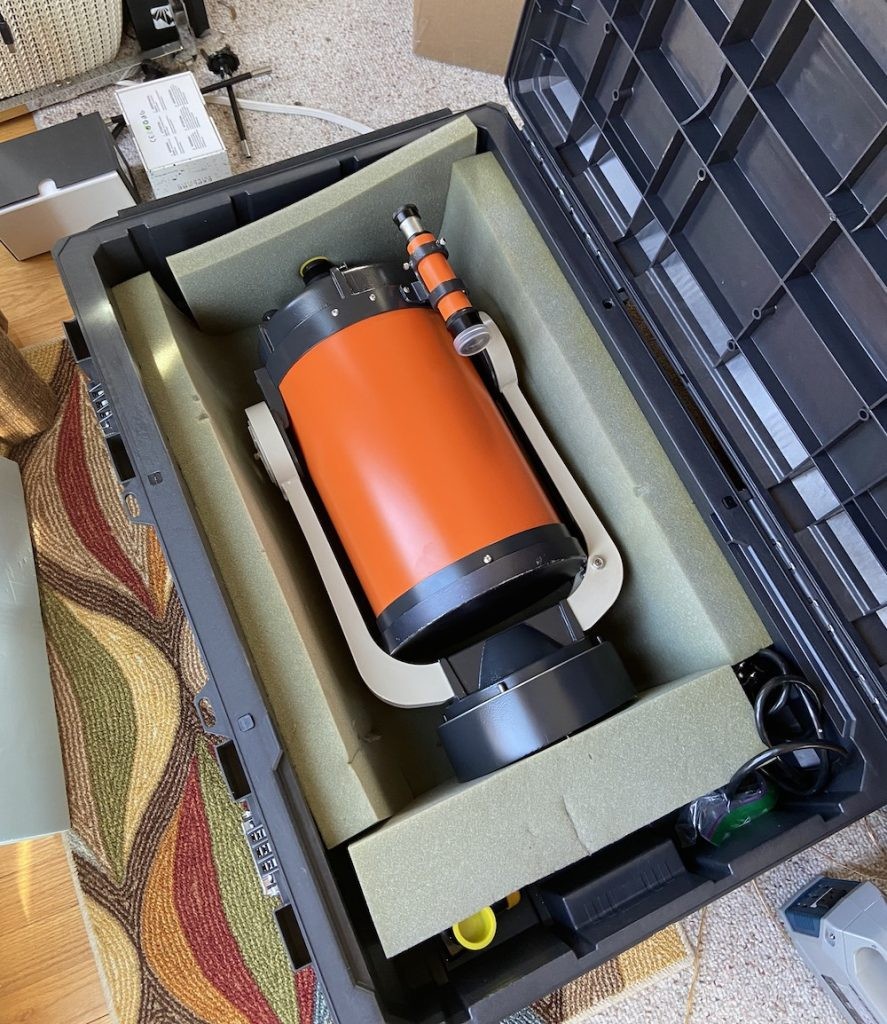

For those who often transport their telescopes in vehicles, wrapping the optical tube assembly (OTA), mounts, and tripods in a thick towel or blanket provides sufficient protection against minor bumps and scratches. If your telescope has a fairly stubby tube, you can put it upright in a car seat and buckle it in, but otherwise, just stopping your telescope/mount and other hardware from rolling around or going flying at a sharp turn or sudden stop is really all you need to do.
If you feel the need for an extra layer of protection during storage or transport, a generic wheeled case from a big-box store or a sturdy plastic bin can serve the purpose. These are often more cost-effective and can be padded with foam or bubble wrap for added safety.
Eyepieces, being smaller and more delicate, benefit from a more secure storage solution. High-quality Pelican-type cases, which are watertight and rugged, are excellent for this purpose. The hard shell protects against physical damage, while the foam inserts can be customized to snugly fit each eyepiece, preventing movement. If you can’t afford a Pelican case, the padded cases from Seahorse, as well as the Apache line offered by Harbor Freight, are some good picks; almost any quality pluck-foam case for cameras, firearms, or other precision hardware will do.
Inside these cases, it’s advisable to store at least one or two small silica gel desiccant packs. You can shove them under the foam at the bottom or top of the case. These small packets absorb excess moisture, ensuring the eyepieces remain dry and free from potential fungal growth. Remember to replace or recharge desiccants periodically, especially in humid climates.
Avoid touching the optical surface of any telescope’s lens or mirror directly. Fingerprints contain oils that can damage the optical coatings. Directly touching the sides of the glass of a lens or mirror to grab hold of one, or any holder/housing, is fine, of course.
Proper cleaning of telescope lenses and mirrors is essential for optimal performance. While some may be hesitant, fearing damage or preferring professional servicing, cleaning can be straightforward and cost-effective if done correctly. Our guide to cleaning telescope optics as well as our recoating and caring for telescope mirrors article go into more detail, but we’ll go over some tips here in brief too.
For telescope objectives or front corrector plates that have accumulated fingerprints, pollen, or dew residue, immediate cleaning is essential. These substances can degrade optical coatings or chemically etch the glass of some lenses, causing permanent and irreversible damage to the optical surface. Eyepieces, frequently exposed to eyelash oils, makeup, and accidental smudges, also benefit from periodic cleaning to maintain clarity.
However, it’s essential to remember that, except for potentially harmful residues or excessive dust and dirt, frequent cleaning isn’t always necessary. Dust is mostly harmless to optical performance, unless in significant amounts. If you’re dealing with mere dust, a bulb blower is ideal for cleaning without touching the lens. Compressed air can be too forceful and may deposit residues, making bulb- or squeeze-type blowers a safer choice.
For stubborn residues like fingerprints or eyelash oils, a liquid solvent solution is necessary. Using disposable wipes, like pre-moistened Zeiss wipes, in gentle circular motions ensures effective cleaning without scratching. For smaller, harder-to-reach optics, Q-tips dipped in lens cleaner or LensPens can be handy.
Mirrors, however, have their own set of guidelines. Light dust layers on mirrors are best left undisturbed, as cleaning may cause more harm than the dust itself. But if the mirror becomes significantly dirty or encounters harmful substances like pollen or insect waste, a cleaning process involving tap water, mild dish soap, and distilled water rinse will suffice.
If your telescope has electronic components, regularly check the batteries to ensure they aren’t leaking, which can damage the internal circuitry. For computerized telescopes, ensure that the firmware is regularly updated to have the latest features and bug fixes.
If you’re taking your telescope outside from a warm room in cold weather, give it time to acclimate to allow the optics to cool to ambient temperature and provide sharp images. Avoid leaving your telescope under direct sunlight for extended periods, as this can heat and potentially damage the optics—or worse, with some open-tubed designs or without a lens cap, a ray of sunlight could actually strike the optics and be focused inside the telescope, potentially setting it or nearby objects ablaze.
If your observing location requires walking up or down stairs, or you can’t handle carrying something too heavy, or if you just decide you want to travel a lot with your scope, choosing a smaller one might be a better idea. 8″ Dobsonians are what we consider to be perfect in terms of the balance between portability and viewability.
While it’s amazing to peer through a large scope, it’s useless if it isn’t used. This goes for kids too. If you’re shopping telescope for a child, remember to choose something they can manage on their own.
A Few Frequently Asked Questions
Where should I buy telescopes from?
Amazon, Agena Astro, High Point Scientific, Orion Telescopes & Binoculars, Oceanside Photo and Telescope (OTPCorp), Omegon, and Tejraj are all trustworthy retailers of telescopes with excellent customer service.
Which telescope brand is better – Meade, Celestron or Orion?
Almost all of the major telescope brands make great products—and unfortunately, they all market irredeemable garbage at low price points, using their good reputations to fool newcomers. Brand loyalty or image should never be a factor in choosing a telescope or accessories.
How much is a decent telescope?
A decent telescope can cost as little as $100, but we recommend spending at least $150 to $200 for something good with no compromises. You get what you pay for.
Can you see galaxies with a telescope?
Any telescope can at least show you the Andromeda Galaxy, but the quality of your views and the number of galaxies depends on your telescope’s aperture, your light pollution and sky conditions, and your skill as an observer.
Are telescopes easy to maintain and service?
The most complicated things you’ll generally need to do to your telescope are to collimate it (at least check every time you take it out) and clean the optics every few months or years. Collimation requires nothing more than a star and/or a collimation tool and is explained in our guide, while cleaning is generally little more than a rinse with distilled water (for mirrors) or cleaning with optical tissue and coating-safe lens cleaner or lens wipes (for lenses).
Why are Dobsonian telescopes considered the best?
Dobsonian telescopes have smooth and simple motions—up and down, left and right with no complicated equatorial coordinates or locks or levers. Their simple construction means they’re also relatively lightweight, cheap, and easy to assemble, meaning you can put your money and focus on the telescope tube itself. The Dobsonian’s Newtonian reflector optical design also provides you the most aperture for your buck allowing you to see more of the Universe – and without the pesky chromatic aberration of a refractor.
Small, medium, & large telescopes – What’s the difference?
Usually, when astronomers refer to amateur-sized telescopes, they lump them into several classes.
“Small” used to refer to telescopes of 6 inches of aperture or less, but the trend of larger and larger telescopes means that most astronomers today term “small” as being 8 inches of aperture or less.
“Medium” usually refers to telescopes with an aperture of between 8 and 13.1 inches. Larger amateur telescopes (almost all of which are Dobsonians) pretty much require truss tubes to be managed by one person and fit in an automobile.
“Large” is a confusing term because there is no set definition as to where it ends. Some people would call a 30” Dob a “large telescope”. However, we would term it to be anything between 14” and 22” in aperture. A 22” is about the largest one-person scope you can buy.
“Very large” usually refers to telescopes above 22” of aperture. Telescopes above 22” (with the exception of some very exotic and groundbreaking ATM builds) are simply not manageable by one person and seldom fit in a regular car or truck. They also typically cost over $10,000, so few tend to own them. The largest amateur-owned telescopes you typically see are 36” to 42” in aperture, but there are some 50-inch, 60-inch, and even two 72-inch amateur telescopes that either exist or are in development.
Ultimate Telescopes Shortlist
These are the contenders for the Best Telescope Award, from which we chose 10 awardees.
Tabletop Dobsonians Shortlist
- Skywatcher Heritage 150P Tabletop Dobsonian
- Sky-Watcher Heritage 130p Tabletop Dobsonian
- Sky-Watcher Virtuoso GTi 150P Tabletop Dobsonian GoTo
- Sky-Watcher Virtuoso GTi 130P Tabletop Dobsonian GoTo
Dobsonians Shortlist
- Sky-Watcher 6″ Classic Dobsonian
- Apertura AD8 Dobsonian
- Celestron StarSense Explorer 8” Dobsonian PushTo
- Explore Scientific FirstLight 8″ Dobsonian
- Explore Scientific 10″ Hybrid Dobsonian
- Sky-Watcher 8″ Classic Dobsonian
- Sky-Watcher 8 Flextube Collapsible Dobsonian
- Apertura AD10 Dobsonian
- Celestron StarSense Explorer 10” Dobsonian
- Sky-Watcher 10″ Classic Dobsonian
- Explore Scientific 10″ Truss Tube Dobsonian
- Sky-Watcher 10″ Flextube Collapsible Dobsonian
- Apertura AD12 Dobsonian
- Celestron StarSense Explorer 12″
- Sky-Watcher 8″ Flextube SynScan Collapsible Dobsonian GoTo
- Sky-Watcher 12″ Flextube Collapsible Dobsonian
- Explore Scientific 12″ Truss Tube Dobsonian
- Sky-Watcher 10″ Collapsible Dobsonian GoTo
- Sky-Watcher 12″ Flextube Dobsonian GoTo
Reflector Telescopes (Non Dobsonian) Shortlist
Refractor Telescopes Shortlist
Maksutov Cassegrain Telescopes Shortlist
Schmidt Cassegrain Telescopes Shortlist
- Celestron Nexstar 6SE Schmidt-Cassegrain GoTo
- Celestron NexStar Evolution 6 Schmidt-Cassegrain GoTo
- Celestron Advanced VX 6″ SCT GoTo
- Celestron 8″ NexStar Evolution Schmidt Cassegrain GoTo
- Celestron Advanced VX Series 8″ Schmidt-Cassegrain GoTo
- Celestron Advanced VX 9.25″ Schmidt-Cassegrain GoTo
- Celestron NexStar Evolution 8″ EdgeHD with StarSense GoTo
- Celestron CGEM II 800 SCT GoTo
- Celestron Advanced VX 8″ EdgeHD
- Celestron 9.25″ NexStar Evolution Schmidt Cassegrain GoTo

Very informative and helpful, thank you
Thanks for the information! I’ve been searching for one as a present for my husband. He loves to look up at the stars and try and find constellations and stars/planets, etc. Would #4 or #5 be better for him just stargazing and wanting to see more definition in the planets/stars? I don’t know what the difference is on relating to that! Just looking for help, even after reading the reviews and comparisons! Thanks for any and all help!
Get #5, vastly superior
Thank you!! 😊👍🏻
Very well written, and also very helpful! Thank you for this information!
Look for the Dobsonians sold by GSO and Omegon, they are very similar.
Hi Zane,
I’m looking for my first telescope since high school. I’ll be spending most of my time looking at DSO’s. I’ve been looking at the Evolution 9.25 and it seems manageable to me. If I were to purchase something with a little bit larger aperture, a shorter focal ratio, and a mirror with as good or better quality lens, what do you feel would be a good way to go? A telescope which can be broken apart to carry works best. I’m pretty sure I can manage any single piece of 25-30 lbs, but 30lbs is pushing it if it’s the tube itself. Thanks!
Hi Steve,
Personally I’m not sure whether I’d go for the Evolution 9.25. It is a little unsteady on its supplied mount. I have a C9.25 AVX and love it but the longer C9.25 tube really needs a steady mount like the CPC or a CGEM.
I would highly recommend the Sky-Watcher 10″ Collapsible (with or without GoTo) – you’d be surprised how easy it is to move the tube (it is a bit over 30 pounds but has plenty of places to grab), and the base isn’t too much trouble. It’s a lot cheaper, more stable, and has more light gathering ability as well as a wider field of view.
I live in an area with some light pollution. Celina, Ohio area. Dobsonians are the best for viewing because of light gathering? What is the best compact one that can do what a 12″-14″ dobsonians can do? Schmidt-Cassegrain type is what I’m talking about for ease of portability. My budget is $3000.00 or so. I want to be able to see and also be mobile. Thank you so much
What you are asking for doesn’t exist. Large SCTs are extremely bulky and actually harder to manage than a Dob.
Hi Zane,
Appreciate your reviews thank YOU.
Want to buy my first telescope very confusing yet frustating to say the least when it comes to decision making !! 🤪
Seems like Zhumell is your fav
Unfortunately not available in Turkey. For my budget Meade & Celestron has put me off after reading your reviews,found a web site that distubutes Omegon,Orion& Sky Watcher brands .
Overall i would like something that will blow me away ..even though on a resticted budget🙄 tossing up on Orion dobsonians / reflectors ..but Omegon is a new brand for me .
I woul appreciate it greatly if you could compare both brands..just want enjoy the greater skies..planets nebula galaxies or any unexplained out there😃 cheers &TIA
I think Omegon has a tabletop Dobsonian line, I’d go with one of those scopes.
Thanx ..i ‘ll keep that in mind whilst im ddeciding.btw can i send afew links for you to spare afew mins of yr time though Tia😉
Hi Zane
Just wondering what the determents on calculating light gathering power &how can i calculate a telescopes
Light gathering power,i believe there is a formular cheers
http://www.stargazing.net/naa/scopemath.htm
G’day Zane ..
Trying to get my first telescope
Just need a hand though,limited in choice due budget
Hoping u can spare time to help make that decision a bit easier
In much appreciation .Cheers
Dobs
-ORİON SKYQUEST XT8 CLASSİC DOBSONİAN TELESCOPE
-Omegon Dobson Telescope Advanced X N 203/1200
-Skywatcher Dobson Telescope N 200/1200 Skyliner Classic DOB
Newts
– SKYWATCHER TELESCOPE N 114/500 SKYHAWK-1145PS AZ-EQ AVANT
-ORİON STARBLAST II 4.5 EQ REFLECTOR & ASTROTRACK MOTOR DRİVE
Get one of the Dobsonians, preferably the Omegon or Skywatcher (whichever is cheaper)
Hi Zane thank you for yr advice ..dont know why but to me Orion has written ‘Buy me ‘ all over it
I ‘ve read your X review Orion xt8/Skywatcher 8″ dobs .With respect to your rating《Skyliner 5☆》and《Orion xt8 4.8☆》Though it seems that Orion has a better overall rating as opposed to Skywatcher ,as i’m indeed newbie did i miss a point other than Skywatcher had more accessories?
Could you kindly round it up in laymans terms for it to sink in
Ps.i have provided specifics of 3 diff dobs (not in anyorder of preferance ) ,pls pls pls if u could generously in brief let me know whyone is better than the other ..i would be everso grateful..
**Omegon Dobson Telescope Advanced XN 203/1200
Telescope Type Reflector (Mirror Telescope)
Telescope Structure Newton
Mirror Diameter 203 mm
Focal Length 1200 mm
Focus Ratio f / 6
Separation Force 0.58
Limit Brightness Mag 13.3
Light Gathering Capacity 820
Maximum Magnification 400x
Optical Tube Weight 10.2 kg
Optical Tube Structure Full Tube
Focuser 2 ” Crayfird
Stock Type Dobson
Stock Dobson
GoTo Control No
Tracking No
Tripod Wooden
Eyepieces (1.25 ”) 1.25 ” Plossl 25mm
Finder 8×50
Accessory Tray Yes
Total weight 20.4 kg
Series Advenced X
Observable Objects Moon & Planets, Nebula & Galaxy
***Skywatcher Dobson Telescope N 200/1200 Skyliner Classic DOB
Design Newton
Mirror Diameter 200mm
Focal Length 1200mm
Focus Ratio f / 6
Separation Force 0.58
Limit Brightness Mag 13.3
Light Gathering Capacity 820
Maximum Usable Magnification 400x
Tube Weight 11 kg
Tube Structure Full Tube
Focuser Crayford
Connection of Focuser to Eyepiece 2nd”
Stock Dobson
GoTo Control No
Tracking No
Stock Material Wooden
Eyepieces (1.25 ”) 25mm, 10mm
Finder Binoculars 9×50
Eyepiece Adapter 1.25 ” – 2 ”
Total weight 26 kg
Observable Objects Moon and Planets, Nebula and Galaxies
***Orion SkyQuest XT8 Classic Dobsonian
Optical Design Reflector (Mirrored Telescope)
Optic Diameter 203mm
Focal Length 1200mm
Focus Ratio f / 5.9
Main Mirror Structure Parabolic
Glass Material Low Thermal Expansion Borosilicate Glass
Eyepieces (1.25 ”) Sirius Plossl 25mm
Magnification with Eyepieces 48x
Separation Force 0.57arcsec
Lowest Magnification 29x
Theoretical Maximum Magnification 406x
Limit Brightness Magnitude 14.2
Optical Quality Diffraction Limited
Finder Binoculars EZ Finder II Red Dot Finder
Focuser 2 ” Crayford (with 1.25 ” adapter)
Secondary Mirror Block 47mm
Secondary Chuck Blocking Diameter 23%
Secondary Mirror Block Area 5%
Mirror Coating Aluminum & Silicon Dioxide
Stock Type Dobson
Computer Compatibility –
Tube Material Steel
Tripod Material Wooden
Optical Tube Length 118.1 cm
Optical Tube Weight 9.2 kg
Stock / Tripod Weight 9.38 kg
Total weight 18.6 kg
Observation Area Moon, Planets, Bright Deep Space.
CHEERS
With utter respect THANK YOU FOR YOUR INVALUABLE TIME ZANE .
I like the Omegon, but you’ll need to get a 9mm or 10mm eyepiece for it. Same with the XT8. All three are good scopes and very similar.
Very much appreciate professionalisim on the subject .Thanx for yr replies ..cheers 🚀🛰🪐🌞☄🌠🌝🙂🙂🙂🙂
Thank you for the wonderful reviews and info. Looking for a nice beginner telescope that can grow along with our experience. Family of 4 and want to keep at lake house. Really want to be able to see planets, moon. $500ish budget.
Thank you for your help
Zhumell Z8 or 8″ Skywatcher
HI Zane – Thanks for your reviews. We are in Sydney and light pollution is high. My son is 10 year old and we are looking to buy a decent telescope for viewing. Can you recommend one
What is your budget? We have listed scopes in various budget categories in this article.
Hey Zane,
I’m been wanting to purchase a telescope for a very long time and I really appreciate your feedback on the ones you mentioned. I’m a newbie at telescopes but I’ve been looking at the skywatcher 6” and the 8” just wondering what is the big difference between the two. The 8” is around the $445 range while the 6” is around $315.
Thank you!
The 8″ has about double the light gathering ability and is equally portable. I would go for the 8.
Hi Zane,
Love your telescope reviews and I am wondering what your goto pair of Binocs are. I almost have as much enjoyment using my cheap pair as I do my scope but am looking to upgrade.
Cheers,
Eric
Hi, i am a newbie and buying my my first telescope. I’m very limited on my budget can you recomend me a telescope.My friend (Who is also relatively new) told me that i should buy the orion Skyscanner 100 or the Orion Observer 114mm. I have heard about the skyscanner 100 but never about the second one. on paper it looks like a good deal considering they about the same price.
Sorry about the bad grammar🗿
Thanks for the help
The SkyScanner is sturdier, more portable, and has better optics – get the SkyScanner
Your grammar is fine, don’t worry!
One of the best web pages I’ve visited in a while. Very helpful.
Thank you, glad we could help!
Love this article! Looking for high quality to look at the planets. Someone told me to get the
StarSense Explorer 12″ Smartphone App-Enabled Dobsonian Telescope
Your thoughts on this particular telescope? Are there better for cheaper or better for around the same price? Will it handle all planets, stars, comets, sky things etc well?
Appreciate your feedback!
It’s a great choice, though you’ll want better eyepieces than what’s supplied. The Apertura AD12 has a little more bang for your buck but the StarSense Explorer is also nice to have.
Hi Zane! Do you still recommend the Sarblue as the best budget telescope? I’m looking to get my husband a telescope for Christmas. He has never used one before but is really into all things space related! Would like to get him an inexpensive one then work our way up if he’s into it. Thanks!
Yes, it’s excellent though the tabletop Dobsonians do offer better performance on deep-sky objects. Glad to help!